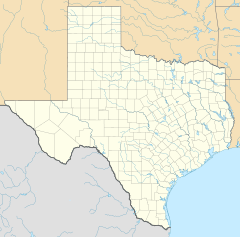Caverns of Sonora facts for kids
Quick facts for kids Caverns of Sonora |
|
|---|---|
| Location | Sutton County, Texas, United States |
| Nearest city | Sonora, Texas |
| Designated: | 1965 |
The Caverns of Sonora is a super cool cave in Texas, USA. It's known as a National Natural Landmark because it's so special. You can find it about 8 miles (13 km) west of Sonora. This cave is famous worldwide for its amazing calcite crystal formations. Especially unique are the helictites, which are twisted, worm-like crystals. They are everywhere in this cave, often looking incredibly pure and complex. One spot is so full of them, people call it the "snake pit"! Bill Stephenson, who started the National Speleological Society, once said it was "the most indescribably beautiful cave in the world."
Contents
History
How the Caverns Formed
The Caverns of Sonora formed in limestone rock that is about 100 million years old. This rock was laid down during the Cretaceous period. The cave itself probably started forming between 1.5 and 5 million years ago.
It formed when special gases rose from deep underground. These gases mixed with water in the aquifer, which is an underground layer of water. This mix created very acidic water. This acidic water then slowly dissolved the limestone rock, carving out the cave passages.
After the water drained from the cave, which happened between 1 and 3 million years ago, the famous mineral formations began to grow. These formations are called speleothems. They include things like stalactites, stalagmites, and the unique helictites.
The Famous Butterfly Formation
The cave's most famous formation was known as the "butterfly." It was truly one-of-a-kind, with no other known formation like it anywhere else. It was made of two "fishtail" helictite growths that met at a single point on the cave wall. Sadly, in November 2006, about a third of its right wing broke off.
Development
Early Discoveries
Local ranch-hands knew about the first quarter-mile of the cave by the early 1900s. They called it Mayfield Cave, after the landowner, Stanley Mayfield. In 1955, Stanley Mayfield gave permission to four cave explorers from Dallas. These explorers discovered another seven miles (11 km) of passages. These new areas included the most beautiful parts of the cave that we see today.
Opening to the Public
To protect the cave from damage, a steel gate was put at the entrance on June 15, 1957. The cave was then secretly renamed "Secret Cave" to keep its location hidden.
In 1957, Jim Papadakis, a geologist and photographer, fell in love with the cave. He was a member of the National Speleological Society. Jim noticed that delicate cave formations were being broken by careless explorers. He realized that the best way to protect the "Secret Cave" was to open it to the public. He wanted it to be a "showcase cave" with guided tours.
In February 1960, Jim made a deal with Stanley Mayfield to develop the cave. This project included building a fenced road, installing power lines, and setting up a telephone line. They also drilled a water-well and built a small visitor center. Jim hired his friend Jack Burch to help build the trails and install electric lights for safe public tours.
Jim decided to name the cave "Caverns of Sonora" after the nearby town of Sonora. The cave officially opened for public tours on July 16, 1960.
Recognition and Protection
In 1961, Jim sold the Caverns of Sonora to nine investors from Sonora. They formed a company with Stanley Mayfield as its head. In April 1963, the Texas House of Representatives gave the Caverns of Sonora a special award. Then, on December 1, 1965, the National Park Service added the Caverns to the National Register of Natural Landmarks. This recognition helps protect the cave for future generations.
See also
- Lechuguilla Cave
- In Spanish: Cavernas de Sonora para niños



